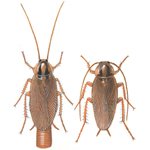
Cockroaches, that look exactly like the ones we see today, have existed for at least 250 million years. Their way of life has probably been more or less as the current cockroaches, except that it would take approximately 250 million years before the first cockroach got the chance to eat crumbs in kitchens.
Only a few members of this ancient insect family give cockroaches their bad reputation. The vast majority of the more than 4000 different known species live out in nature, and have as little to do with people as possible.
We also have a few species of outdoor cockroaches in Northern Europe. Small, neat insects that can be found in forests and dunes.
Cockroaches are predominantly tropical animals, and kitchen cockroaches also demand heat and are not found outdoors. It is only during the last few hundred years they have gained a place in these latitudes. Earlier on our homes were too poorly heated.
The German cockroach is not particular German, but Carl von Linné who named it Blatella germanica must have thought so.
The first sign that you have cockroaches in your house is quite large, slightly flattened animals with long legs and very long antennae that run into hiding when a light is turned on at night in the kitchen.
The adult German cockroach is about one cm long, brownish with two dark stripes on the breastplate. It has a pair of flying wings under the elytra but rarely makes any use of them.
After mating the female lays the eggs in a special capsule. It is divided into 30-40 small rooms containing an egg each. Many species leave the capsules, but the German cockroach carries it around, sticking out of the vulva, until the offspring is ready to swarm out. The offspring is wingless and relatively wide and dark compared to the adults. They evolve through 6-7 nymphal stages, and at 30 degrees C. they are fully grown in just two months. At a temperature of down to 21 degrees C. the development lasts half a year.
Cockroaches are gregarious insects, and they are often found in large numbers in those places where they hide during daylight. they have certain fragrances that form in their glands in the intestine and these fragrances are excreted with the faeces, which attracts them to each other and which they perceive by the sense organs in the antennae. It has been proven that a lone, young cockroach thrive poorly and grows more slowly than when it has company. Apparently the young cockroaches stimulate each other in some way.
The German cockroaches thrive in warm, moist places with access to water. This means that the usual living spaces are behind washing machines and ovens and in cracks behind the other heat sources.
The spread of cockroaches happens predominantly passive, along with products and packaging, but they can also easily spread in a property through piping or vent ducts.
Cockroaches can damage food by chewing, by polluting with their droppings and by that extremely unpleasant odour that cockroaches have.
Finally they can transfer germs to the goods, something that hardly has any significance in most countries today compared to other disease transfers.
You should always exterminate cockroaches, and in shared kitchens and food companies you are even obligated to do so.
Their high reproductive potential and hidden lifestyle makes them difficult to exterminate, and it does not get any easier knowing that the cockroaches are among the insects that quickly develop resistance to the pesticides on the market.
When cockroaches are found in an apartment in a residential building there is a risk of spreading the cockroaches, if you only exterminate locally. There must be an extermination strategy, and as a minimum the adjacent apartments must also be examined and treated if necessary.
In most cases, you should contact a professional company with an understanding of pest control, as cockroaches as mentioned can be difficult to exterminate. We will probably never get totalt rid of them.
The Oriental cockrach In Europe the Oriental cockroach (Blatta orientalis) is not nearly as common as the German. It is larger, grows up to 2.5 cm long and is shining black. the females have small elytra, while the elytra of the males almost cover the entire abdomen. Its way of life is largely as the German cockroach, but it requires higher temperatures to thrive. An important difference is that the female is not carrying the egg capsule around, but places it in the dark sheltered place. The capsule cracks after a few months and the small nymphs come out. This means that new cockroaches can appear months after the last adult is exterminated.
American cockroach The largest of those cockroaches that we occasionally encounter is the American cockroach (Periplaneta americana). Both sexes have elytra that are longer than the body. This cockroach is often introduced from overseas, and a few American cockroaches are lucky enough to escape to a place where it is hot and humid, perhaps in a heated greenhouse or conservatory, where they can survive, but under other conditions they will die quickly.




